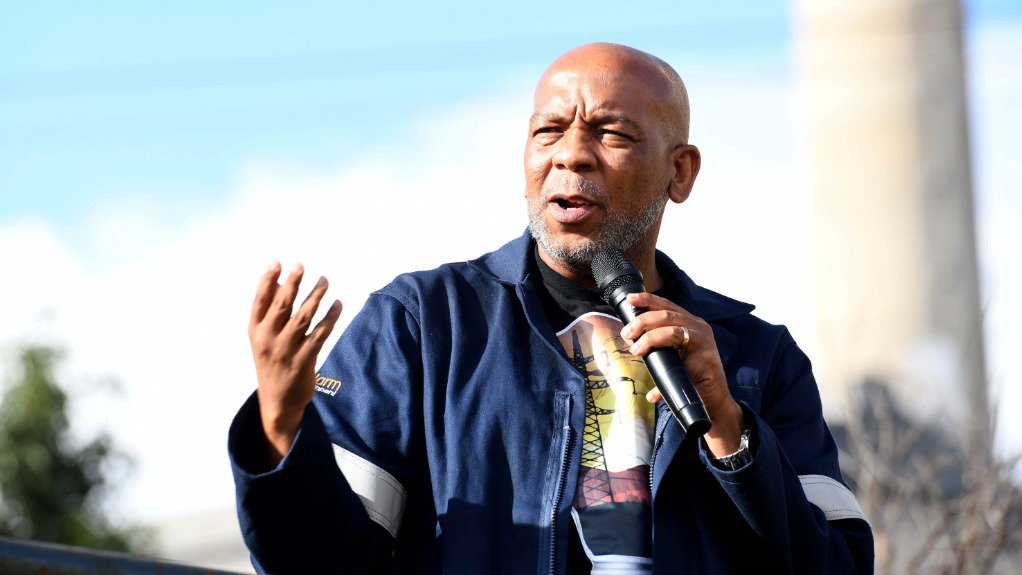Separation of energy portfolio and Ramokgopa’s appointment praised amid rising energy-transition complexity


Dr Kgosientsho Ramokgopa speaking during an Eskom power station visit while still Electricity Minister
The decision to establish a separate energy portfolio with the African National Congress’s Dr Kgosientsho Ramokgopa as Minister and the Democratic Alliance’s Samantha Graham as Deputy Minister has been welcomed by stakeholders and commentators alike.
There are already warnings, however, that the success of the new Electricity and Energy Ministry will be judged not only on ensuring a permanent end to loadshedding but on whether it is able to shepherd South Africa, justly, through the unfolding energy transition in a way that addresses not only the immediate threats to security of supply and affordability but also long-term sustainability and competitiveness.
Business Unity South Africa energy and environment policy director Happy Khambule welcomed the establishment of the standalone entity, which had been merged with mineral resources during the previous administration.
The ministry’s separation, along with three others, has resulted in the number of Cabinet posts under the government of national unity rising to 32 from 30 and the number of Deputy Ministerial positions increasing to 43.
The creation of a “focused” ministry was also supported by Energy Council of South Africa CEO James Mackay who told Engineering News that it “bodes well for dealing with our broader energy challenges and delivering a national energy transition”.
Likewise, the University of Cape Town’s Professor Anton Eberhard described the restructuring as a “good development”, arguing that all the provisions of the Electricity Regulation Act (ERA), including electricity planning and procurement, will now fall under Ramokgopa, which should facilitate more effective implementation than was the case under Mineral Resources and Energy Minister Gwede Mantashe.
That said, he warned that “lumping” petroleum with Mantashe’s new Mineral and Petroleum Resources Ministry could have unintended adverse consequences for the energy sector, especially for proposed gas-to-power projects that “might be prejudiced as a result”.
“South Africa will need gas-fired power plants to complement the growing share of variable renewable energy on the grid.
“Already, we have a confusing number of State actors doing their own thing (Transnet, Central Energy Fund, the Independent Power Producer Office, Eskom, etc) and the lack of coordination, and the absence of internationally experienced transaction advisers, means there is a high probability that these procurement or investment initiatives will fail or, at best, be too late,” Eberhard told Engineering News.
PETROLEUM PUZZLE
South African Independent Power Producer Association (SAIPPA) CEO Brian Day also raised concerns, saying it would be important to outline what was involved in the "petroleum" part of the minerals and petroleum portfolio to create clarity between that and energy.
Khambule, too, stressed the need to treat energy matters in an integrated manner, highlighting that South Africa faced acute energy challenges beyond electricity insecurity.
“While electricity supply issues may be mitigated for the foreseeable future, we confront an impending gas supply cliff, a lack of clarity in energy planning and require crucial decisions regarding energy procurement investments that enable the introduction of new generation capacity and energy infrastructure.
“Additionally, urgent interventions are needed for transmission and reticulation networks to ensure the provision of energy services,” Khambule said.
NEW ENERGY
All those canvassed by Engineering News were, nevertheless, highly appreciative of the appointment of Ramokgopa to the role, with energy commentator Chris Yelland praising him for the vigorous approach he had taken to the issue of loadshedding after his appointment as Minister in the Presidency Responsible for Electricity.
“Minister Ramokgopa has really been the face of the reduction of loadshedding … and I think it is good for him to be rewarded with high political office for this achievement.
“He has brought a new energy to the whole question of energy and electricity, very welcome energy, and he's instilled greater confidence,” Yelland said in an interview with Engineering News.
SAIPPA’s Day added that Ramokgopa had “a positive impact within the previous arrangement and will be able to have an even greater impact in the full ministry now created”, while Solar Photovolatic Industry Association CEO Dr Rethabile Melamu highlighted the good relationship the association had with Ramokgopa, which was established during his previous role.
“The Minister has a solid appreciation of the contribution that solar PV can and has made to the country's electricity supply. We look forward to again working alongside his ministry to contribute to energy security by tapping into the abundant solar resources that the country can access,” Melamu said.
South African Wind Energy Association Niveshen Govender highlighted Ramokgopa’s role in stabilising South Africa’s power supply and expressed optimism that he would play a positive role in addressing some of the challenges facing the wind industry.
“We have high expectations from the newly formed Ministry of Electricity and Energy to work with industry and overcome sector challenges, including grid constraints, regulatory and policy uncertainty, as well as local manufacturing limitations.
“To mitigate these, there is a critical need to accelerate the integration of wind energy as part of the county’s energy mix and requires policy and strategic intervention to ensure an affordable, stable and reliable electricity supply across South Africa,” Govender said.
Eberhard believes “things can only get better with the new Minister”, describing the fact that Mantashe was able to introduce just 150 MW of new publicly procured electricity during his five-year tenure as a “terrible indictment” given the intensity of the crisis.
SCALE OF THE CHALLENGE
The scale of the challenge confronting both Ramokgopa and Graham were also highlighted by all those canvassed, with Mackay noting that the Energy Council had already outlined the need for direct capital investment of R1.8-trillion in the electricity sector alone over the coming ten years.
While such investment represented an opportunity to unlock over 500 000 new jobs, there were a myriad of policy, regulatory and implementation hurdles to overcome, making it essential, in Khambule’s assessment, for the ministry to “hit the ground running”.
“The incoming ministers must focus on implementing key energy sector reforms and advancing the Just Energy Transition,” he said, while arguing for the swift promulgation and enforcement of the amended ERA legislation, which still awaited Ramaphosa’s signature.
“This [the ERA] is fundamental to building investor confidence and maintaining the pace of our electricity sector reform,” Mackay added, while Yelland said it was going to be important for the legal concerns regarding the possible negative implications for local government raised to be overcome speedily so that the new framework could be introduced.
The Energy Intensive Users Group of South Africa’s (EIUG’s) Fanele Mondi said it was a matter of urgency that the ERA be signed into law.
Mondi argued that, with loadshedding abating, there was “still so much that is required to transform the industry to achieve the objectives of energy security, price affordability, accessibility and decarbonisation of our energy mix”.
The ERA was not the only legislative change that required attention, though, with Khambule also highlighting the need for immediate attention to be given to the Gas Amendment Bill, the South African National Petroleum Company, and the National Nuclear Regulator Amendment Bill.
There were also serious concerns about the state of energy regulation, a concern amplified by the fact that the National Energy Regulator of South Africa (Nersa) was being challenged regularly, and successfully, in the courts.
“Regarding regulatory oversight, the Ministers must ensure that the Nersa adopts an appropriate Electricity Price Determination Methodology. Swift resolution of matters related to subsidy charges and the determination of special subsidies is also critical,” Khambule added.
BETTER PLANNING
Yelland, meanwhile highlighted the need for far better planning, including the finalisation of an Integrated Energy Plan; a long unfulfilled legislative requirement and one that the courts have now instructed should be met by the end of March 2025.
He also believes the current draft update to the Integrated Resources Plan for electricity, which has been widely rejected by stakeholders, should be withdrawn and rewritten before being released again for public consultations.
However, Yelland is particularly concerned about the perilous state of the highly fragmented distribution sector, where the prevailing tariff methodology is failing both municipalities and residents, particularly the most vulnerable residents.
“The problems we see in electricity distribution are just a symptom of a very much wider problem relating to the funding of municipalities, and I think the National Treasury and the Department of Cooperative Governance and Traditional Affairs bear a huge responsibility in relooking at the whole financial model of municipalities.”
The EIUG’s Mondi added that electricity distribution industry and municipal reform were required urgently to enable distribution transformation and sustainability.
There were also major changes under way upstream of distribution, in the transmission sector, that would have to be carefully navigated.
In fact, Mackay says it will be crucial to “keep a strong focus” on the National Transmission Company South Africa (NTCSA), which began operating as an independent entity under Eskom Holdings on July 1, the day after the Cabinet announcement.
Besides the need to rapidly expand grid capacity, which could be aided in future by independent transmission providers, it was envisaged that the NTCSA would progressively take on complex roles as the country transitions to a multi-market model.
“The current work on market codes is very good but does not cover the broader implementation challenges and risks.
“A total market framework and risk assessment is required when considering the complex work and integration of market codes, regulations, Nersa, industry preparation for trading and new financial instruments that must be in place in less than a year,” Mackay told Engineering News.
Then, there was also the need to continue with Eskom’s turnaround, while preparing for the decommissioning of the coal plants, as well as the opportunity to leverage the industrialisation potential of the energy transition through the South Africa Renewable Energy Masterplan.
Tackling such complex problems simultaneously, Mackay said, would require the collaboration and partnerships established through the National Energy Crisis Committee and Operation Vulindlela to remain intact.
“If we can rapidly expand capacity to deal with these challenges, whilst maintaining good governance and reporting on progress, then we will set up our energy sector for success,” he said.
Article Enquiry
Email Article
Save Article
Feedback
To advertise email advertising@creamermedia.co.za or click here
Comments
Announcements
What's On
Subscribe to improve your user experience...
Option 1 (equivalent of R125 a month):
Receive a weekly copy of Creamer Media's Engineering News & Mining Weekly magazine
(print copy for those in South Africa and e-magazine for those outside of South Africa)
Receive daily email newsletters
Access to full search results
Access archive of magazine back copies
Access to Projects in Progress
Access to ONE Research Report of your choice in PDF format
Option 2 (equivalent of R375 a month):
All benefits from Option 1
PLUS
Access to Creamer Media's Research Channel Africa for ALL Research Reports, in PDF format, on various industrial and mining sectors
including Electricity; Water; Energy Transition; Hydrogen; Roads, Rail and Ports; Coal; Gold; Platinum; Battery Metals; etc.
Already a subscriber?
Forgotten your password?
Receive weekly copy of Creamer Media's Engineering News & Mining Weekly magazine (print copy for those in South Africa and e-magazine for those outside of South Africa)
➕
Recieve daily email newsletters
➕
Access to full search results
➕
Access archive of magazine back copies
➕
Access to Projects in Progress
➕
Access to ONE Research Report of your choice in PDF format
RESEARCH CHANNEL AFRICA
R4500 (equivalent of R375 a month)
SUBSCRIBEAll benefits from Option 1
➕
Access to Creamer Media's Research Channel Africa for ALL Research Reports on various industrial and mining sectors, in PDF format, including on:
Electricity
➕
Water
➕
Energy Transition
➕
Hydrogen
➕
Roads, Rail and Ports
➕
Coal
➕
Gold
➕
Platinum
➕
Battery Metals
➕
etc.
Receive all benefits from Option 1 or Option 2 delivered to numerous people at your company
➕
Multiple User names and Passwords for simultaneous log-ins
➕
Intranet integration access to all in your organisation















